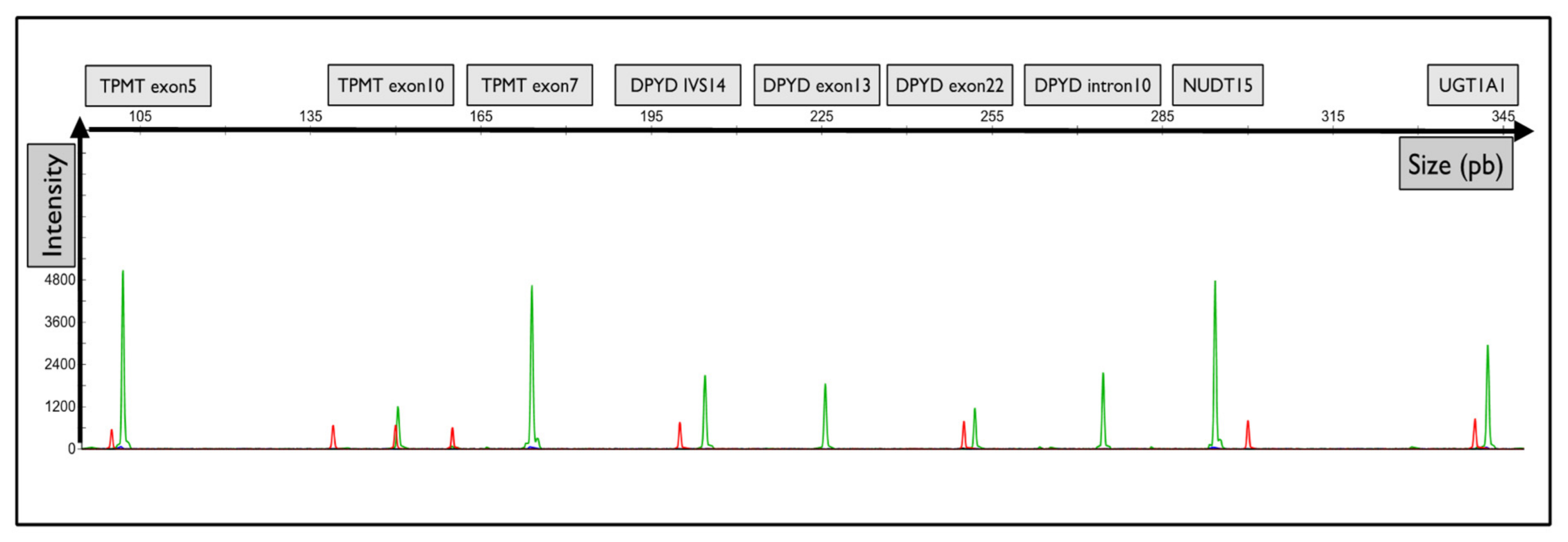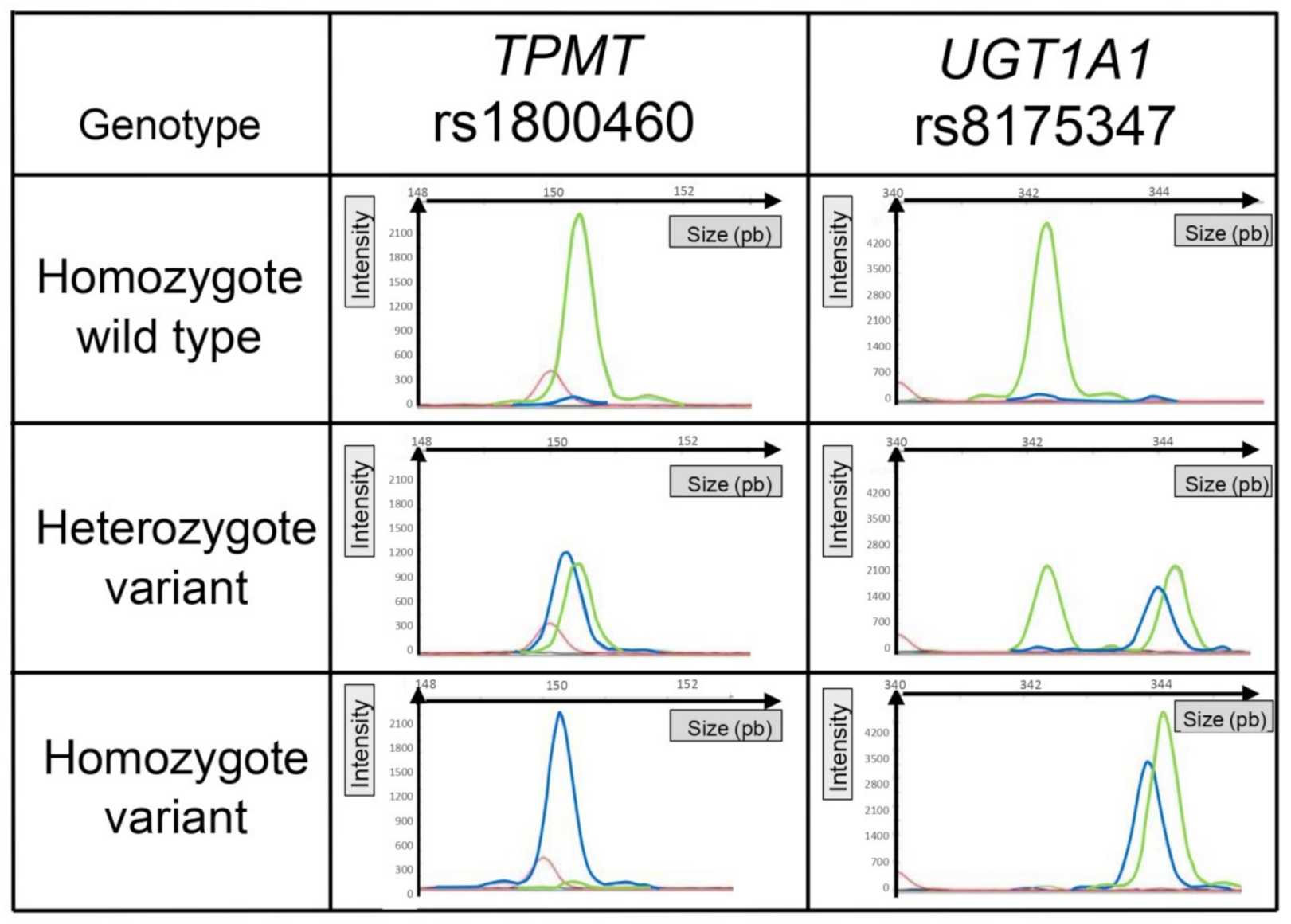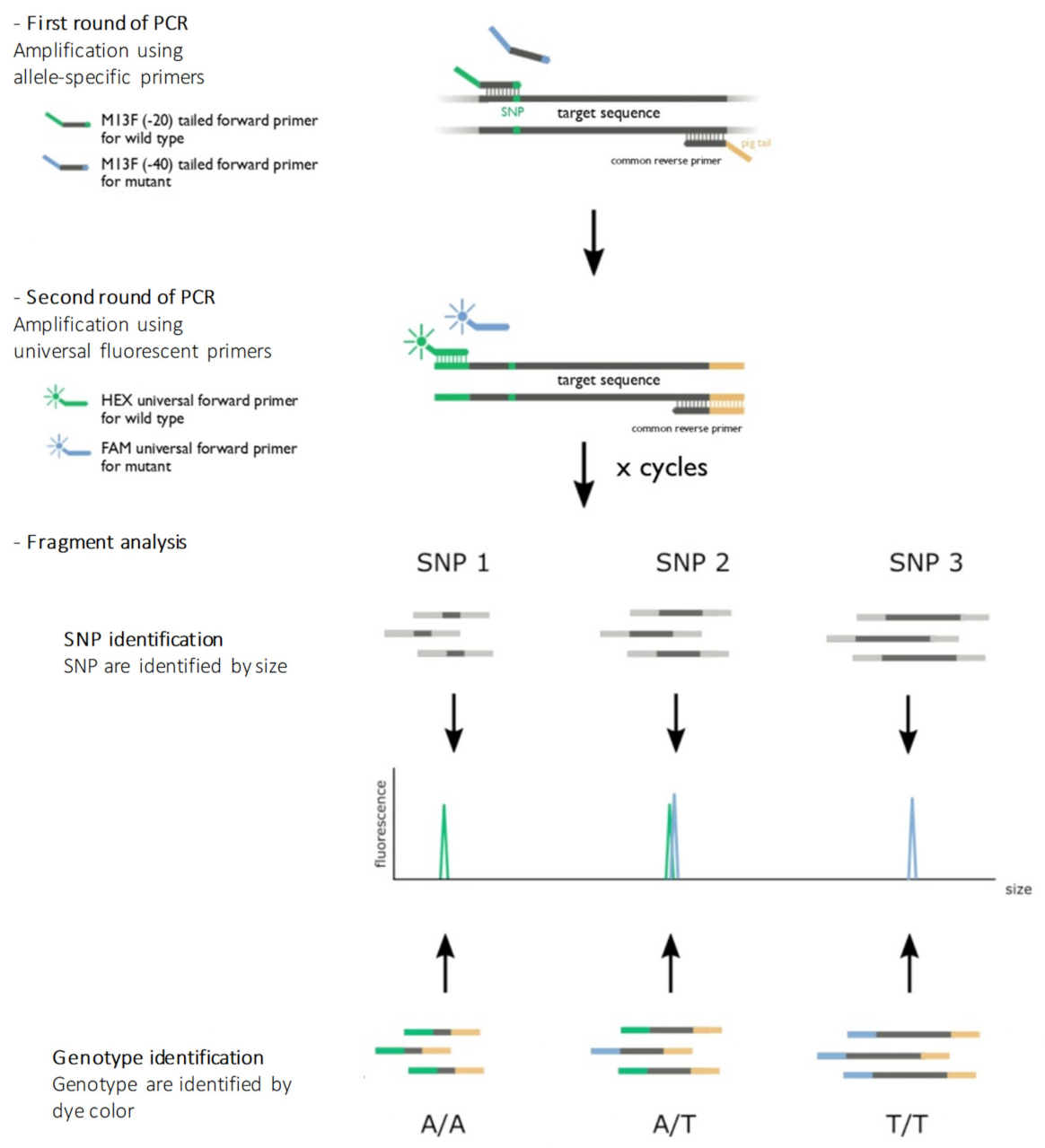PharmFrag: An Easy and Fast Multiplex Pharmacogenetics Assay to Simultaneously Analyze 9 Genetic Polymorphisms Involved in Response Variability of Anticancer Drugs
Abstract
1. Introduction
2. Results
2.1. Multiplex PCR Protocol Optimization
2.2. Validation of the Protocol
2.2.1. Repeatability
2.2.2. Accuracy
2.2.3. Robustness and Intersample Contamination
2.2.4. Stability
3. Material and Methods
3.1. Samples and DNA Extraction
3.2. Reference Method
3.3. Principle of the Assay and Design of the Primers
3.4. PCR Multiplex Amplification
3.5. Genotyping and Fragment Analysis
3.6. Internal Control Samples
3.7. Validation of the Assay
4. Discussion and Conclusions
Supplementary Materials
Author Contributions
Funding
Acknowledgments
Conflicts of Interest
References
- Quaranta, S.; Thomas, F. Pharmacogenetics of anti-cancer drugs: State of the art and implementation–recommendations of the French National Network of Pharmacogenetics. Therapie 2017, 72, 205–215. [Google Scholar] [CrossRef] [PubMed]
- Relling, M.V.; Schwab, M.; Whirl-Carrillo, M.; Suarez-Kurtz, G.; Pui, C.-H.; Stein, C.M.; Moyer, A.M.; Evans, W.E.; Klein, T.E.; Antillon-Klussmann, F.G.; et al. Clinical Pharmacogenetics Implementation Consortium Guideline for Thiopurine Dosing Based on TPMT and NUDT15 Genotypes: 2018 Update. Clin. Pharmacol. Ther. 2019, 105, 1095–1105. [Google Scholar] [CrossRef] [PubMed]
- Páez, D. Genetics and adverse events with irinotecan treatment: What do we know? Pharmacogenomics 2019, 20, 393–395. [Google Scholar] [CrossRef] [PubMed]
- Amstutz, U.; Henricks, L.M.; Offer, S.M.; Barbarino, J.; Schellens, J.H.M.; Swen, J.J.; Klein, T.E.; McLeod, H.L.; Caudle, K.E.; Diasio, R.B.; et al. Clinical Pharmacogenetics Implementation Consortium (CPIC) Guideline for Dihydropyrimidine Dehydrogenase Genotype and Fluoropyrimidine Dosing: 2017 Update. Clin. Pharmacol. Ther. 2018, 103, 210–216. [Google Scholar] [CrossRef] [PubMed]
- Wiita, A.P.; Schrijver, I. Clinical application of high throughput molecular screening techniques for pharmacogenomics. Pharmgenomics Pers. Med. 2011, 4, 109–121. [Google Scholar] [CrossRef] [PubMed]
- Homo_sapiens—Ensembl Genome Browser 102. Available online: http://www.ensembl.org/Homo_sapiens/Info/Index (accessed on 16 September 2020).
- Schuelke, M. An economic method for the fluorescent labeling of PCR fragments. Nat. Biotechnol. 2000, 18, 233–234. [Google Scholar] [CrossRef] [PubMed]
- Lamas, M.J.; Duran, G.; Balboa, E.; Bernardez, B.; Touris, M.; Vidal, Y.; Gallardo, E.; Lopez, R.; Carracedo, A.; Barros, F. Use of a comprehensive panel of biomarkers to predict response to a fluorouracil-oxaliplatin regimen in patients with metastatic colorectal cancer. Pharmacogenomics 2011, 12, 433–442. [Google Scholar] [CrossRef] [PubMed]



| Gene | Name | Polymorphism (Location) | Frequency of the Minority Allele (%) a | Consequence of the Allelic Variant on Protein Functionality |
|---|---|---|---|---|
| TPMT | Thiopurine S-methyltransferase | rs1800462 (exon 5) | 1 | Reduced |
| rs1142345 (exon 10) | 4 | Reduced | ||
| rs1800460 (exon 7) | 3 | Reduced | ||
| NUDT15 | Nudix hydrolase 15 | rs116855232 | 4 | Reduced |
| DPYD | Dihydropyrimidine dehydrogenase | rs55886062 (exon 13) | 0.1 | Reduced (75%) |
| rs3918290 (IVS 14) | 0.5 | No activity (Truncated) protein | ||
| rs67376798 (exon 22) | 0.7 | Reduced (30%) | ||
| rs75017182 (Hap B3–intron 10) | 2.4 | Reduced | ||
| UGT1A1 | UDP glucuronosyltransferase family 1 member A1 | rs8175347 (*28) | 29–45 | Reduced |
| Gene | Genetic Polymorphism | Genotype | Number of DNA Samples (Multiplex Method) | Concordance with Reference Method |
|---|---|---|---|---|
| TPMT | rs1800462(ex5) | WT | 69 | 100% |
| varHz | 6 | 100% | ||
| rs1800460(ex7) | WT | 52 | 100% | |
| varHz | 20 | 100% | ||
| varHm | 3 | 100% | ||
| rs1142345(ex10) | WT | 46 | 100% | |
| varHz | 26 | 100% | ||
| varHm | 3 | 100% | ||
| NUDT15 | rs116855232 C>T | WT | 16 | 100% |
| varHz | 3 | 100% | ||
| DPYD | rs3918290(IVS14) | WT | 133 | 100% |
| varHz | 5 | 100% | ||
| rs55886062(ex13) | WT | 128 | 100% | |
| varHz | 1 | 100% | ||
| rs67376798(ex22) | WT | 125 | 100% | |
| varHz | 4 | 100% | ||
| rs75017182(int10) | WT | 121 | 100% | |
| varHz | 6 | 100% | ||
| UGT1A1 | rs8175347 (*28) | WT | 17 | 100% |
| varHz | 27 | 100% | ||
| varHm | 6 | 100% |
| DNA Amount | ||||||||
|---|---|---|---|---|---|---|---|---|
| Polymorphism | 1 ng | 5 ng | 10 ng | 25 ng | 50 ng | 100 ng | 250 ng | 500 ng |
| TPMT rs1800462 | 30 | 131 | 138 | 3064 | 4426 | 3455 | >7500 | 6425 |
| TPMT rs1142345 | 43 | 158 | 184 | 2999 | 4219 | 3301 | >7500 | 7048 |
| TPMT rs1800460 | 73 | 264 | 283 | 6385 | 7612 | 7105 | 3005 | 6198 |
| DPYD rs3918290 | N.D. | 77 | 153 | 3151 | 4185 | 3198 | >7500 | 7140 |
| DPYD rs55886062 | N.D. | 129 | 171 | 2568 | 3633 | 2945 | 6599 | 7096 |
| DPYD rs67376798 | 33 | 74 | 117 | 2467 | 3437 | 2578 | 6548 | 7232 |
| DPYD rs75017182 | 36 | 141 | 163 | 3108 | 4625 | 3719 | >7500 | >7500 |
| NUDT15 rs116855232 | 73 | 313 | 371 | 7532 | 7596 | 7601 | >7500 | >7500 |
| UGT1A1 rs8175347 | N.D. | 61 | 81 | 1602 | 2335 | 1845 | 4339 | 5813 |
| Polymorphism | Mean Intensity with Fresh Mix | Mean Intensity with Mix FT5 | Mean Bias (%) (FT5 vs. Fresh) |
|---|---|---|---|
| TPMT rs1800462 | 441 | 320 | −31 |
| TPMT rs1142345 | 2012 | 1229 | −41 |
| TPMT rs1800460 | 5453 | 3209 | −44 |
| DPYD rs3918290 | 2543 | 1352 | −49 |
| DPYD rs55886062 | 2081 | 1321 | −38 |
| DPYD rs67376798 | 1712 | 1097 | −37 |
| DPYD rs75017182 | 3086 | 1376 | −56 |
| NUDT15 rs116855232 | 5583 | 2622 | −54 |
| UGT1A1 rs8175347 | 2498 | 1165 | −52 |
| Mean | 2823 | 1521 | −45 |
| Gene Position | Primer ID | Primer Sequences (5–3′) | Variants Detected | Amplicon Size (pb) | Primer Final Concentration in the Mix (pmol/µL) |
|---|---|---|---|---|---|
| TPMT rs1800462 (exon 5) | F-TPMT5-WT | GTAAAACGACGGCCAGTGTGTAAATGTATGATTTTATGCAGGCTTG | rs1800462 | 104 | 0.01 |
| F-TPMT5-var | GTTTTCCCAGTCACGACGTGTAAATGTATGATTTTATGCAGGCTTC | 0.01 | |||
| R-TPMT5 | GTTTCTTGTATCCCAAGTTCACTGATTTCCAC | 0.25 | |||
| TPMT rs1800460 (exon 7) | F-TPMT7-WT | GTAAAACGACGGCCAGTCAAATTTGACATGATTTGGGATAGAAGAG | rs1800460 | 173 | 0.01 |
| F-TPMT7-var | GTTTTCCCAGTCACGACCAAATTTGACATGATTTGGGATAGAAGAA | 0.01 | |||
| R-TPMT7 | GTTTCTTAGTCTAAGCTGATTTTCTAGAACCC | 0.7 | |||
| TPMT rs1142345 (exon 10) | F-TPMT10-WT | GTAAAACGACGGCCAGTGGAATTGACTGTCTTTTTGAAAAGTGATA | rs1142345 | 152 | 0.01 |
| F-TPMT10-var | GTTTTCCCAGTCACGACGGAATTGACTGTCTTTTTGAAAAGTGATG | 0.01 | |||
| R-TPMT10 | GTTTCTTCCATTACATTTTCAGGCTTTAGCA | 1 | |||
| DPYD rs3918290 (IVS 14) | F-DPYD-IVS14-WT | GTAAAACGACGGCCAGTCTCTTGTTTTAGATGTTAAATCACACCTAC | rs3918290 | 204 | 0.01 |
| F-DPYD-IVS14-var | GTTTTCCCAGTCACGACCTCTTGTTTTAGATGTTAAATCACACCTAT | 0.01 | |||
| R-DPYD-IVS14 | GTTTCTTGTTTCCCCCAGAATCATCCG | 0.7 | |||
| DPYD rs55886062 (exon 13) | F-DPYD-ex13-WT | GTAAAACGACGGCCAGTTCCAGCTTCAAAAGCTCTTAGAA | rs55886062 | 226 | 0.01 |
| F-DPYD-ex13-var | GTTTTCCCAGTCACGACTCCAGCTTCAAAAGCTCTTAGAC | 0.01 | |||
| R-DPYD-ex13 | GTTTCTTCCAAGTATTGGTTTGTATTTTGCAG | 1 | |||
| DPYD rs67376798 (exon 22) | F-DPYD-ex22-WT | GTAAAACGACGGCCAGTCCACAGTTGATACACATTTCTCCAT | rs67376798 | 254 | 0.01 |
| F-DPYD-ex22-var | GTTTTCCCAGTCACGACCCACAGTTGATACACATTTCTCCAA | 0.01 | |||
| R-DPYD-ex22 | GTTTCTTCCAGTCTCCCAAGTTAATATAATGC | 1 | |||
| DPYD rs75017182 (Hap B3-intron 10) | F-DPYD-int10-WT | GTAAAACGACGGCCAGTCTGAATATGGAGGTGAAAATCACAGC | rs75017182 | 274 | 0.01 |
| F-DPYD-int10-var | GTTTTCCCAGTCACGACCTGAATATGGAGGTGAAAATCACAGG | 0.01 | |||
| R-DPYD-int10 | GTTTCTTGGATATGAATGCTTCTCCTCATGG | 0.7 | |||
| UGT1A1 rs8175347 (*28) | F-UGT1A1-WT | GTAAAACGACGGCCAGTTGTATCGATTGGTTTTTGCCATATATATATACATA | rs8175347 | 343–345 | 0.01 |
| F-UGT1A1-var | GTTTTCCCAGTCACGACTGTATCGATTGGTTTTTGCCATATATATATACATATA | 0.01 | |||
| R-UGT1A1 | GTTTCTTGGCACAGGGTACGTCTTCAA | 1 | |||
| NUDT15 rs116855232 | F-NUDT15-WT | GTAAAACGACGGCCAGTCCAGCTTTTCTGGGGATTGC | rs116855232 | 293 | 0.01 |
| F-NUDT15-var | GTTTTCCCAGTCACGACCCAGCTTTTCTGGGGATTGT | 0.01 | |||
| R-NUDT15 | GTTTCTTTCTCAAGTACTGGCTGAAAGAGT | 0.7 |
Publisher’s Note: MDPI stays neutral with regard to jurisdictional claims in published maps and institutional affiliations. |
© 2020 by the authors. Licensee MDPI, Basel, Switzerland. This article is an open access article distributed under the terms and conditions of the Creative Commons Attribution (CC BY) license (http://creativecommons.org/licenses/by/4.0/).
Share and Cite
Bouvet, R.; Verdier, M.-C.; El Baroudi, Y.; Galibert, M.-D.; David, V.; Schutz, S.; Tron, C. PharmFrag: An Easy and Fast Multiplex Pharmacogenetics Assay to Simultaneously Analyze 9 Genetic Polymorphisms Involved in Response Variability of Anticancer Drugs. Int. J. Mol. Sci. 2020, 21, 9650. https://doi.org/10.3390/ijms21249650
Bouvet R, Verdier M-C, El Baroudi Y, Galibert M-D, David V, Schutz S, Tron C. PharmFrag: An Easy and Fast Multiplex Pharmacogenetics Assay to Simultaneously Analyze 9 Genetic Polymorphisms Involved in Response Variability of Anticancer Drugs. International Journal of Molecular Sciences. 2020; 21(24):9650. https://doi.org/10.3390/ijms21249650
Chicago/Turabian StyleBouvet, Régis, Marie-Clémence Verdier, Yahya El Baroudi, Marie-Dominique Galibert, Véronique David, Sacha Schutz, and Camille Tron. 2020. "PharmFrag: An Easy and Fast Multiplex Pharmacogenetics Assay to Simultaneously Analyze 9 Genetic Polymorphisms Involved in Response Variability of Anticancer Drugs" International Journal of Molecular Sciences 21, no. 24: 9650. https://doi.org/10.3390/ijms21249650
APA StyleBouvet, R., Verdier, M.-C., El Baroudi, Y., Galibert, M.-D., David, V., Schutz, S., & Tron, C. (2020). PharmFrag: An Easy and Fast Multiplex Pharmacogenetics Assay to Simultaneously Analyze 9 Genetic Polymorphisms Involved in Response Variability of Anticancer Drugs. International Journal of Molecular Sciences, 21(24), 9650. https://doi.org/10.3390/ijms21249650





